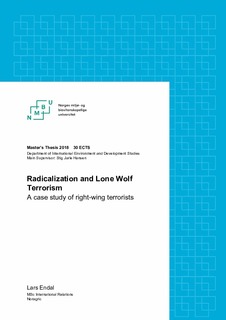| dc.contributor.advisor | Hansen, Stig Jarle | |
| dc.contributor.author | Endal, Lars | |
| dc.date.accessioned | 2018-06-28T07:10:57Z | |
| dc.date.available | 2018-06-28T07:10:57Z | |
| dc.date.issued | 2018 | |
| dc.identifier.uri | http://hdl.handle.net/11250/2503433 | |
| dc.description.abstract | The lone wolf terrorism issue is a difficult problem to understand and the tactic has gained increased attention in the last decade. It is, however, a less researched field compared to other kinds of terrorism research. The field of radicalization and extremism has focused mainly on individuals who join terrorist groups or networks and the radicalization processes that are characteristic for groups. By using process tracing to qualitatively assess two right-wing lone wolves, this case study seeks to supplement the current research on lone wolf terrorism, in order to broaden the understanding of what makes an individual carry out an attack alone.
The aim of this thesis has thus been to investigate how lone wolves emerge, especially with regards to internal thought-processes and behavior. Their motivations and social environment has been analyzed to understand more about their life and possible events that may have influenced them into carrying out their terror attacks. The two cases were selected from different time periods and cultures, and the analysis has tested one general theory on the radicalization process of terrorism and one specific theory on the radicalization of lone wolves.
The theories could overall describe the two selected cases well, and the findings of this thesis are thus additional empirical evidence that the theories are valid. The two cases differ somewhat in motivations, but still followed approximately the same process. There were three distinct commonalities that drove the cases to use violence. First, they both grew up in dysfunctional environments, thus producing insecurity and various degrees of paranoia. Second, they were both ignored and they did not feel that their right to be heard was acknowledged. Third, the use of violence may have been a way to portray themselves as something greater than themselves, where the act would represent their commitment to their cause. It is important to note that their motivations are perceived transgressions against them or the group they identify positively with. | nb_NO |
| dc.language.iso | eng | nb_NO |
| dc.publisher | Norwegian University of Life Sciences, Ås | nb_NO |
| dc.rights | Navngivelse 4.0 Internasjonal | * |
| dc.rights.uri | http://creativecommons.org/licenses/by/4.0/deed.no | * |
| dc.subject | Right-wing extremism | nb_NO |
| dc.subject | Solo terrorism | nb_NO |
| dc.subject | Extremism | nb_NO |
| dc.title | Radicalization and lone wolf terrorism : a case study of right-wing terrorists | nb_NO |
| dc.type | Master thesis | nb_NO |
| dc.subject.nsi | VDP::Samfunnsvitenskap: 200::Statsvitenskap og organisasjonsteori: 240 | nb_NO |
| dc.subject.nsi | VDP::Samfunnsvitenskap: 200 | nb_NO |
| dc.source.pagenumber | 86 | nb_NO |
| dc.description.localcode | M-IR | nb_NO |

